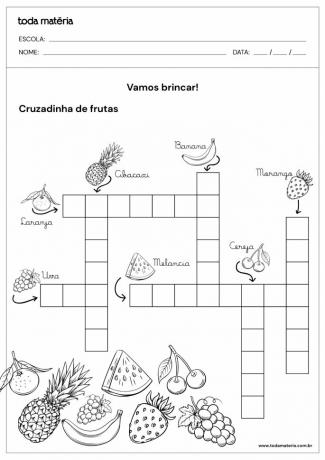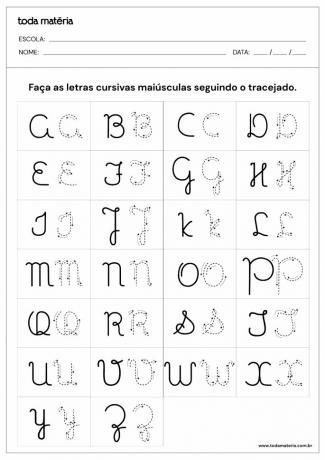Check out activity sheets for kids to practice cursive handwriting. See also suggestions for activities for teachers, which include saying words from a poem, copying comics, music and writing a message of praise or thanks.
Activity 1: copying sentences in cursive

Activity 2: Word dictation in cursive
The teacher asks the students to write, in cursive, the words he says. Then, he dictates the words aloud and as we normally say them, that is, without syllables. Say the word and repeat.
It is interesting that the words of the saying are in context, such as words from a story told or a poem recently recited.
Suggested poem words for the dictation: duck - goofy - mug - chicken - mallard - perch - foot - horse - kick - rooster - piece - jenipapo - well - bowl - pot
The Duck, by Vinicius de Moraes
here comes the duck
Paw here, paw there
here comes the duck
To see what's there.
the goofy duck
painted the mug
beat the chicken
hit the mallard
jumped off the perch
at the foot of the horse
got kicked
created a rooster
ate a piece
genipap
got choked
With pain in the crotch
fell into the well
broke the bowl
So many did the boy
What went into the pot?
Activity 3: names in cursive
Make cards with the names of each student in the class in cursive. Decorate them and place them, with adhesive clay, in a place accessible to all.
Encourage the children to pick up their name card whenever they need to write in their notebook or on an activity sheet.
After some time, encourage the children to pick up the card with their classmates' names to write their names in their notebooks or sheets. Organize the room so that each time one takes the name of a different colleague. In this way, children learn to write not only their own name, but also the names of all the classmates in the room.
Activity 4: crossword with cursive letter

Activity 5: copying a comic in cursive
The teacher asks the children to choose a comic to copy using cursive. The comic should be written on a piece of paper that they can later decorate as they wish, because after reading it to their colleagues, it should be displayed in the room.
Next, the teacher asks each child to read the chosen comic aloud, learning to recite and expanding their repertoire of comics.
Frame suggestions:
I planted an avocado tree
to eat avocado.
But I don't know what to plant
to eat chocolate.
Potato when born
it spreads across the floor.
little girl when she sleeps
put your hand on your heart.
Broody hen
ate worm.
jumped out
like popcorn.
Activity 6: Dictation of sentences with cursive handwriting
The teacher asks the students to write, in cursive, the sentences he says. Then, he begins to dictate each of the words aloud and as we normally speak them, that is, without syllables. Say the words one by one and repeat.
It is interesting that the saying phrases are in context, such as phrases that are part of a recently told story or a song they usually sing. But, do not say anything until the children themselves understand what they are writing.
Song suggestion:
The frog does not wash the foot.
He doesn't wash because he doesn't want to.
He lives down by the lagoon.
What foot odor!
Poem Suggestion:
Point of view, by Pedro Bandeira
I am small, they tell me,
and I get angry.
I have to look at everyone
with the chin lifted.
But if ant could talk
and he saw me there from the ground,
would definitely say:
"My goodness, what a big boy!"
Activity 7: Copying uppercase and lowercase letters of the alphabet in cursive

Activity 8: Copying a story in cursive
The teacher explains that they are going to write a story together. It proposes a theme and gives each person the opportunity to tell a little part of the story, asking questions whose answers will be used in their development (When and what happened?, Who was there?).
The theme can be some activity that took place at school, for example. As they tell the story, the teacher writes on the board and encourages students to use less common words in order to enrich their vocabulary. For example, instead of using too big or yummy, use huge or yummy.
The story should be short so that it fits in the frame. Only at the end, children should copy it to the notebook using cursive.
Activity 9: Tracing capital letters of the alphabet in cursive

Activity 10: message with cursive handwriting
The teacher asks the children to write, with the help of someone at home, a small message - of praise or thanks, for example, to a classmate. The message must be written in cursive and must be identified with the name of the sender and recipient.
On the agreed day, the teacher collects the messages and checks that each child has at least one message to receive. If you don't have it, the teacher writes to the children who don't have it.
The delivery of messages can be done by raffling, where each child takes one and announces who is the recipient of the message he/she drew, delivering it. The delivery can also be done by the teacher, who can put the messages on each one's desk - with a small piece of sticky dough - to surprise the children when they arrive in the classroom classroom.
See too:
Portuguese lesson plans (1st year of Elementary School)
Portuguese activities for the 2nd year (Elementary School)
FERNANDES, Marcia. Cursive Letter: Calligraphy Activities for Kids.All Matter, [n.d.]. Available in: https://www.todamateria.com.br/atividades-de-caligrafia-com-letra-cursiva/. Access at:
See too
- literacy activities
- 1st year Portuguese activities
- Portuguese activities
- verb agreement exercises
- Activities for children's education
- 3rd grade multiplication activities to print
- Mathematics activities for kindergarten
- Cell Wall

